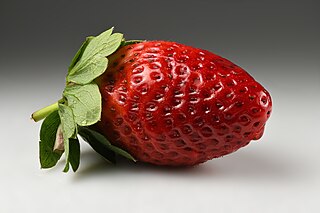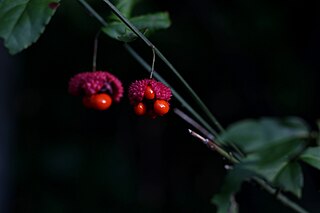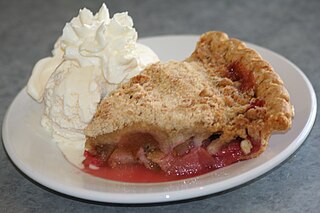
In botany, a fruit is the seed-bearing structure in flowering plants that is formed from the ovary after flowering.

A berry is a small, pulpy, and often edible fruit. Typically, berries are juicy, rounded, brightly colored, sweet, sour or tart, and do not have a stone or pit, although many pips or seeds may be present. Common examples of berries in the culinary sense are strawberries, raspberries, blueberries, blackberries, red currants, white currants and blackcurrants. In Britain, soft fruit is a horticultural term for such fruits.

Potentilla is a genus containing over 300 species of annual, biennial and perennial herbaceous flowering plants in the rose family, Rosaceae.

Starburst is the brand name of a box-shaped, fruit-flavoured soft taffy candy manufactured by The Wrigley Company, which is a subsidiary of Mars, Incorporated. Starburst has many different varieties, such as Tropical, Sour, FaveREDs, Watermelon, Very Berry, Superfruit, Summer Blast and Originalin Mars in 1960, the regular flavours are blackcurrant, lemon and lime, orange and strawberry.

Arbutus unedo is an evergreen shrub or small tree in the family Ericaceae, native to the Mediterranean Basin and Western Europe. The tree is well known for its fruits, the arbutus berry, which bear some resemblance to the strawberry, hence the common name strawberry tree. However, it is not closely related to true strawberries of the genus Fragaria.

The garden strawberry is a widely grown hybrid species of the genus Fragaria, collectively known as the strawberries, which are cultivated worldwide for their fruit. The fruit is widely appreciated for its characteristic aroma, bright red color, juicy texture, and sweetness. It is consumed in large quantities, either fresh or in such prepared foods as jam, juice, pies, ice cream, milkshakes, and chocolates. Artificial strawberry flavorings and aromas are also widely used in products such as candy, soap, lip gloss, perfume, and many others.

Psidium cattleyanum , commonly known as Cattley guava, strawberry guava or cherry guava, is a small tree in the Myrtaceae (myrtle) family. The species is named in honour of English horticulturist William Cattley. Its genus name Psidium comes from the Latin psidion, or "armlet." The red-fruited variety, P. cattleyanum var. cattleyanum, is commonly known as purple guava, red cattley guava, red strawberry guava and red cherry guava. The yellow-fruited variety, P. cattleyanum var. littorale is variously known as yellow cattley guava, yellow strawberry guava, yellow cherry guava, lemon guava and in Hawaii as waiawī. Although P. cattleyanum has select economic uses, it is considered the most invasive plant in Hawaii.
Sunkist Fun Fruits were a licensed snack food from Leaf Confections Limited which were manufactured with fruit from Sunkist Growers, Incorporated. and packaged by Thomas J. Lipton. These bite-sized fruit snacks, which were introduced in 1987, were small, soft and pellet shaped, rather like jellybeans. Initially, the confection was available in four flavors: cherry, grape, orange and strawberry. Later that same year, it was available in assorted shapes such as dinosaurs and rock 'n' roll shapes in order to appeal to children.

Black spot leaf disease is a physiological plant disorder that affects some grape varieties such as Concord. It is essentially a potassium deficiency that causes the leaves on a vine to turn purple and eventually black as chlorophyll is lost. For wine growers this lack of chlorophyll inhibits the vine's ability to transmit sugar to the grape, leaving the resulting grapes with a low brix count that may be less than ideal for wine making.
Xanthomonas fragariae is a species of bacteria. It causes a leaf spot disease found in strawberries. The type strain is NCPPB1469 from Fragaria chiloensis var. ananassa.
Gnomonia comari is a fungus on overwintered leaves of Comarum palustre L. (Rosaceae). The fungus has been recently referred to Gnomoniopsiscomari (Karst.) Sogonov, comb. nov. It occurs in Europe It causes a disease on strawberry.

Gnomonia leptostyla is a fungal plant pathogen. It is newly named Ophiognomonia leptostyla and occurs on walnut and causes leaf blotch and leaf spots which is called walnut anthracnose or walnut black spot. The anamorph is Marssoniella juglandis.
Pestalotia longisetula is a plant pathogen causing strawberry fruit rot.

Fruit preserves are preparations of fruits whose main preserving agent is sugar and sometimes acid, often stored in glass jars and used as a condiment or spread.

Euonymus americanus is a species of flowering plant in the family Celastraceae. Common names include strawberry bush, American strawberry bush, bursting-heart, hearts-a-bustin, and hearts-bustin'-with-love. It is native to the eastern United States, its distribution extending as far west as Texas. It has also been recorded in Ontario.

Fruits are the mature ovary or ovaries of one or more flowers. They are found in three main anatomical categories: aggregate fruits, multiple fruits, and simple fruits.

Gnomonia is a genus of fungi in the family Gnomoniaceae.

Ancylis comptana, the strawberry leaf-roller or Comptan's ancylis moth, is a moth of the family Tortricidae. It is found from the United Kingdom and Scandinavia to northern Spain and Turkey, Asia Minor, Kazakhstan, Uzbekistan, Russia, China, Mongolia, Korea and Japan. In North America, it is represented by ssp. fragariae.

Rhubarb pie is a pie with a rhubarb filling. It is popular in the United Kingdom, where rhubarb has been cultivated since the 1600s, and the leaf stalks eaten since the 1700s. Besides diced rhubarb, it almost always contains a large amount of sugar to balance the intense tartness of the plant. The pie is usually prepared with a bottom pie crust and a variety of styles of upper crust. In the United States, often a lattice-style upper crust is used. This pie is a traditional dessert in the United States. It is part of New England cuisine. Rhubarb has long been a popular choice for pies in the Great Plains region and the Midwest Region, where fruits were not always readily available. Rhubarb pies and desserts are popular in Canada as well, as the rhubarb plant can survive in cold climates.














